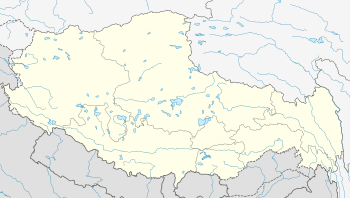Tholing
| Tholing མཐོ་ལྡིང་ 托林镇 Zanda | |
|---|---|
| Town | |
|
| |
 Tholing Location in Tibet | |
| Coordinates: 31°29′03″N 79°48′02″E / 31.48417°N 79.80056°ECoordinates: 31°29′03″N 79°48′02″E / 31.48417°N 79.80056°E | |
| Country | China |
| Region | Tibet |
| Prefecture | Ngari |
| County | Zanda |
| Elevation | 3,723 m (12,215 ft) |
| Population | |
| • Major Nationalities | Tibetan |
| • Regional dialect | Tibetan language |
| Time zone | China Standard (UTC+8) |
| Postal code | 859600 |
| Area code(s) | 0897 |
Tholing (Tibetan: མཐོ་ལྡིང་, Wylie: mtho lding , literally "high place";Chinese: 托林; pinyin: Tuōlín), Toling, Tuolin, or Toding, alternatively Zanda, Tsanda, Tsada, or Zada, is a town and seat of Zanda County, Ngari Prefecture, in the west of Tibet Autonomous Region, People's Republic of China. The town was the former capital of Guge Kingdom in western Tibet when it was ruled by Langdarma. Now an isolated military town, it has a well laid out new street, a post office, and telecommunication facilities.[1][2] The Tholing Monastery, established in 997 AD, is in the suburbs of the town, in the Grand canyon of the Langchen Tsangpo (Sutlej River). Historically, this was an important monastery; the second dissemination of Buddhism in Tibet emanated from it.
History
Zanda is a Chinese name given to the ancient town known as Tholing, which was once the capital of the Ngari district in western Tibet. The town, the monastery, and Tsaparang, a rocky range with forts, played an important role the history of Tibetan Buddhism in west Tibet. Tholing and Tsaparang were the capital cities of the Parang-Guge Kingdom during the 10-11th centuries when Tibetan Buddhism civilization developed. Tholing was on an important trade route between India and Tibet. The Guge Kingdom fell into ruins by the end of 17th century, after the Ladakh army seized this kingdom in 1630 [3] Zanda is now a Chinese military town.
Geography

Recent maps only use the Zanda name, and not Tholing. Zanda sits at an elevation of 3,660 metres (12,010 ft). There are caves in the hills, and a few ruins of chortens located closer to the Sutlej River; the ruins are mostly destroyed but the murals are in very good condition. There are a few poplar trees in the town.[4] A large army establishment is at the southern end of town whereas the Tibetan village is at the northern end of the town. There are a few guest houses between these two locations. The road to Zanda passes through very high snow-covered mountain ranges (in the elevation range of 5,200–5,500 metres (17,100–18,000 ft) along steep slopes and in the descent it passes through the canyon, crosses the Sutlej River at a bridge, and passes through a dry river bed before reaching Zanda.[4]
Notable buildings
Tholing's monastery ruins are within the town limits, while Tsparang's ruins, Gurugem monastery, are 20 kilometres (12 mi) away. Visits to Tholing monastery and the ruins of Tsaparang are only authorized by permit; it is issued by the Cultural Relics Bureau located at Lhasa.[4] A 2011 report, on the "Art and History of the Cultural History of Western Tibet, 8th to 15th century, and Cultural Preservation", states that the Inner Asian Art Style has been identified in the paintings discovered from the cave temples in Zanda of Ngari. Much of the art and architecture were destroyed during the Cultural Revolution.[5]
Villages
The town of Tholing has jurisdiction over the following communities:[6]
- Tuolin Residential Community (托林居委会)
- Bolin Village (波林村)
- Dongga Village (东嘎村)
References
- ↑ McCue, Gary (1 October 2010). Trekking Tibet: A Traveler's Guide. The Mountaineers Books. pp. 235–. ISBN 978-1-59485-266-4. Retrieved 3 January 2013.
- ↑ Swenson, Karen (19 March 2000). "Echoes of a Fallen Kingdom". New York Times. Retrieved 23 January 2013.
- ↑ Mayhew, Bradley; Kelly, Robert; Bellezza, John Vincent (12 February 2008). Tibet. Lonely Planet. pp. 232–. ISBN 978-1-74104-569-7. Retrieved 3 January 2013.
- 1 2 3 Buckley, Michael (1 November 2006). Tibet. Bradt Travel Guides. pp. 44, 224–. ISBN 978-1-84162-164-7. Retrieved 3 January 2013.
- ↑ "Oientations Magazine for collection and connosiures of Asian Art" (PDF). Tibet heritage Fund onizaion. June 2011. Retrieved 27 January 2013.
- ↑ "Toding Town". Cfguide.com. Retrieved 26 January 2013.
